- ▶
- Heaters/Source
- ▶
- Agilent Heaters and SensorsMass Spectrometry, Scientific Supplies & ManufacturingScientific Instrument Services 5973 Source Heater Tamper Resistant Allen Wrench 5973/5975 Quad Sensor 5985 Source Heater Assembly Agilent Interface Heater Assembly 5971 Interface Heater

- ▶
- Reference Material on InstrumentationArticle - A High Temperature Direct Probe for a Mass Spectrometer Design of a Direct Exposure Probe and Controller for use ona Hewlett-Packard 5989 Mass Spectrometer SIS AP1000 AutoProbe™ SIS AP2000 AutoProbe™ - Description of System HPP7: Direct Probe Electronics Console HPP7: Direct Probe for the Agilent (HP) 5973/5975 MSD HPP7: HP Direct Probe Application Notes HPP7: Installation Directions for the Direct Probe HPP7: Side Cover for the HP 5973 MSD HPP7: Support HPP7: Probe Inlet System for the Agilent (HP) 5973 and 5975 MSD with Automatic Indexed Stops HPP7: Theory of Operation of the Direct Probe and Probe Inlet System Direct Thermal Extraction Thermal Desorption Application Notes Environmental Thermal Desorption Application Notes Food Science Thermal Desorption Application Notes Forensic Thermal Desorption Application Notes GC Cryo-Trap Application Notes Headspace Application Notes Purge & Trap Thermal Desorption Application Notes Theory of Operation of the AutoDesorb® System AutoDesorb Notes for SIS Dealers Adsorbent Resin Application Notes Installation of the Short Path Thermal Desorption System on Agilent (HP) and Other GCs Installation of the Short Path Thermal Desorption System on a Varian 3400 GC AutoDesorb® System Development Team Thermal Desorption Applications and Reference Materials Installation of the Short Path Thermal Desorption System - TD5 Part I - Design & Operation of the Short Path ThermalDesorption System Installation Instructions for the Model 951 GC Cryo-Trap on the HP 5890 Series GC Installation Instructions for the Model 961 GC Cryo-Trap on the HP 5890 Series GC Operation of the Model 951/961 GC Cryo-Trap SIS GC Cryo Traps - Theory of Operation NIST/EPA/NIH Mass Spectral Enhancements - 1998 version (NIST98) SIMION 3D Ion Optics Class Mass Spectrometer Source Cleaning Methods MS Tip: Mass Spectrometer Source Cleaning Procedures Mass Spec Source Cleaning Procedures Micro-Mesh® Abrasive Sheets Research Papers Using New Era Syringe Pump Systems EI Positive Ion Spectra for Perfluorokerosene (PFK) Cap Liner Information How do I convert between fluid oz and milliliters? Which bottle material should I choose? Which bottle mouth should I choose? The Bottle Selection Guide CGA Connections for Gas Tanks Chemical Reaction Interface Mass Spectrometry (CRIMS)

- TD
- ▶
- AccessoriesTD Supply Kit Desorption Tubes Adsorbent Resins Desorption Tube Needles Desorption Tube Seals Desorption System Fittings GC Cryo-Trap Extraction Cell TD Sample Loader Prepacked, Conditioned Desorption Tubes Desorption Tube Packing Accessories Stainless Steel Purge Heads Injection Port Liners Tenax TA Poster TD Application Notes Customer Service

- LiteratureApplication Notes Adsorbent Resins Guide Mass Spec Tips SDS Sheets FAQ MS Calibration Compound Spectra Manuals MS Links/Labs/ Organizations MS Online Tools Flyers on Products/Services Scientific Supplies Catalog About Us NextAdvance Bullet Blender® Homogenizer Protocols Micro-Mesh® Literature Instrumentation Literature Agilent GC/MS Literature SIS News / E-Mail Newsletter NIST MS Database - Update Notifications

- ▶
- Purge & Trap Thermal Desorption Application NotesNote 97: Flavor Profiles of Imported and Domestic Beers by Purge & Trap Thermal Desorption GC/MS Note 93: Detection of Benzene in Carbonated Beverages with Purge & Trap Thermal Desorption GC/MS Note 43: Volatile Organic Composition In Blueberries Note 42: The Influence of Pump Oil Purity on Roughing Pumps Note 38: A New Micro Cryo-Trap For Trapping Of Volatiles At the Front Of a GC Capillary Column Note 35: Volatile Organics Composition of Cranberries Note 34: Selection Of Thermal Desorption and Cryo-Trap Parameters In the Analysis Of Teas Note 33: Changes in Volatile Organic Composition in Milk Over Time Note 32: Selection and Use of Adsorbent Resins for Purge and Trap Thermal Desorption Applications Note 31: Volatile Organic Composition in Several Cultivars of Peaches Note 30: Comparison Of Cooking Oils By Direct Thermal Extraction and Purge and Trap GC/MS Note 26: Volatile Organics Present in Recycled Air Aboard a Commercial Airliner Note 25: Flavor and Aroma in Natural Bee Honey Note 23: Frangrance Qualities in Colognes Note 22: Comparison Of Volatile Compounds In Latex Paints Note 21: Detection and Identification Of Volatile and Semi-Volatile Organics In Synthetic Polymers Used In Food and Pharmaceutical Packaging Note 20: Using Direct Thermal Desorption to Assess the Potential Pool of Styrene and 4-Phenylcyclohexene In Latex-Backed Carpets Note 18: Determination of Volatile Organic Compounds In Mushrooms Note 17: Identification of Volatile Organics in Wines Over Time Note 16: Analysis of Indoor Air and Sources of Indoor Air Contamination by Thermal Desorption Note 14: Identification of Volatiles and Semi-Volatiles In Carbonated Colas Note 8: Detection of Volatile Organic Compounds In Liquids Utilizing the Short Path Thermal Desorption System Note 3: Indoor Air Pollution Note 2: Detection of Arson Accelerants Using Dynamic Headspace with Tenax® Cartridges Thermal Desorption and Cryofocusing

- Thermal Desorption Applications and Reference MaterialsDirect Thermal Extraction Headspace Environmental Food Science Applications Pharmaceuticals Forensic Note 103: EPA Method 325B, Novel Thermal Desorption Instrument Modification to Improve Sensitivity Note 102: Identification of Contaminants in Powdered Beverages by Direct Extraction Thermal Desorption GC/MS Note 101: Identification of Contaminants in Powdered Foods by Direct Extraction Thermal Desorption GC/MS Note 100: Volatile and Semi-Volatile Profile Comparison of Whole Versus Cracked Versus Dry Homogenized Barley Grains by Direct Thermal Extraction Note 99: Volatile and Semi-Volatile Profile Comparison of Whole vs. Dry Homogenized Wheat, Rye and Barley Grains by Direct Thermal Extraction GC/MS Note 98: Flavor and Aroma Profiles of Truffle Oils by Thermal Desorption GC/MS Note 97: Flavor Profiles of Imported and Domestic Beers by Purge & Trap Thermal Desorption GC/MS Note 95: Detection of Explosives on Clothing Material by Direct and AirSampling Thermal Desorption GC/MS Note 94: Detection of Nepetalactone in the Nepeta Cataria Plant by Thermal Desorption GC/MS Note 93: Detection of Benzene in Carbonated Beverages with Purge & Trap Thermal Desorption GC/MS Note 88: Analysis of Silicone Contaminants on Electronic Components by Thermal Desorption GC-MS Note 84: Vacuum Pump Exhaust Filters - Charcoal Exhaust Traps Note 83: Vacuum Pump Exhaust Filters - Oil Mist Eliminators Note 82: Vacuum Pump Exhaust Filters Note 80: Design, Development and Testing of a Microprocessor ControlledAutomated Short Path Thermal Desorption Apparatus Note 79: Volatile Organic Compounds From Electron Beam Cured and Partially Electron Beam Cured Packaging Using Automated Short Path Thermal Desorption Note 77: The Determination of Volatile Organic Compounds in VacuumSystem Components Note 75: An Apparatus for Sampling Volatile Organics From LivePlant Material Using Short Path Thermal Desorption Note 73: The Analysis of Perfumes and their Effect on Indoor Air Pollution Note 71: Flavor Profile Determination of Rice Samples Using Shor tPath Thermal Desorption GC Methods Note 65: Determination of Ethylene by Adsorbent Trapping and Thermal Desorption - Gas Chromatography Note 64: Comparison of Various GC/MS Techniques For the Analysis of Black Pepper (Piper Nigrum) Note 63: Determination of Volatile and Semi-Volatile Organics in Printer Toners Using Thermal Desorption GC Techniques Note 60: Programmable Temperature Ramping of Samples Analyzed ViaDirect Thermal Extraction GC/MS Note 57: Aroma Profiles of Lavandula species Note 55: Seasonal Variation in Flower Volatiles Note 54: Identification of Volatile Organic Compounds in Office Products Note 43: Volatile Organic Composition In Blueberries Note 42: The Influence of Pump Oil Purity on Roughing Pumps Note 41: Hydrocarbon Production in Pine by Direct Thermal Extraction Note 40: Comparison of Septa by Direct Thermal Extraction Note 39: Comparison of Sensitivity Of Headspace GC, Purge and Trap Thermal Desorption and Direct Thermal Extraction Techniques For Volatile Organics Note 38: A New Micro Cryo-Trap For Trapping Of Volatiles At the Front Of a GC Capillary Column Note 37: Volatile Organic Emissions from Automobile Tires Note 36: Identification Of Volatile Organic Compounds In a New Automobile Note 35: Volatile Organics Composition of Cranberries Note 34: Selection Of Thermal Desorption and Cryo-Trap Parameters In the Analysis Of Teas Note 33: Changes in Volatile Organic Composition in Milk Over Time Note 32: Selection and Use of Adsorbent Resins for Purge and Trap Thermal Desorption Applications Note 31: Volatile Organic Composition in Several Cultivars of Peaches Note 30: Comparison Of Cooking Oils By Direct Thermal Extraction and Purge and Trap GC/MS Note 29: Analysis Of Volatile Organics In Oil Base Paints By Automated Headspace Sampling and GC Cryo-Focusing Note 28: Analysis Of Volatile Organics In Latex Paints By Automated Headspace Sampling and GC Cryo-Focusing Note 27: Analysis of Volatile Organics In Soils By Automated Headspace GC Note 26: Volatile Organics Present in Recycled Air Aboard a Commercial Airliner Note 25: Flavor and Aroma in Natural Bee Honey Note 24: Selection of GC Guard Columns For Use With the GC Cryo-Trap Note 23: Frangrance Qualities in Colognes Note 22: Comparison Of Volatile Compounds In Latex Paints Note 21: Detection and Identification Of Volatile and Semi-Volatile Organics In Synthetic Polymers Used In Food and Pharmaceutical Packaging Note 20: Using Direct Thermal Desorption to Assess the Potential Pool of Styrene and 4-Phenylcyclohexene In Latex-Backed Carpets Note 19: A New Programmable Cryo-Cooling/Heating Trap for the Cryo-Focusing of Volatiles and Semi-Volatiles at the Head of GC Capillary Columns Note 18: Determination of Volatile Organic Compounds In Mushrooms Note 17: Identification of Volatile Organics in Wines Over Time Note 16: Analysis of Indoor Air and Sources of Indoor Air Contamination by Thermal Desorption Note 14: Identification of Volatiles and Semi-Volatiles In Carbonated Colas Note 13: Identification and Quantification of Semi-Volatiles In Soil Using Direct Thermal Desorption Note 12: Identification of the Volatile and Semi-Volatile Organics In Chewing Gums By Direct Thermal Desorption Note 11: Flavor/Fragrance Profiles of Instant and Ground Coffees By Short Path Thermal Desorption Note 10: Quantification of Naphthalene In a Contaminated Pharmaceutical Product By Short Path Thermal Desorption Note 9: Methodologies For the Quantification Of Purge and Trap Thermal Desorption and Direct Thermal Desorption Analyses Note 8: Detection of Volatile Organic Compounds In Liquids Utilizing the Short Path Thermal Desorption System Note 7: Chemical Residue Analysis of Pharmaceuticals Using The Short Path Thermal Desorption System Note 6: Direct Thermal Analysis of Plastic Food Wraps Using the Short Path Thermal Desorption System Note 5: Direct Thermal Analysis Using the Short Path Thermal Desorption System Note 4: Direct Analysis of Spices and Coffee Note 3: Indoor Air Pollution Note 2: Detection of Arson Accelerants Using Dynamic Headspace with Tenax® Cartridges Thermal Desorption and Cryofocusing Note 1: Determination of Off-Odors and Other Volatile Organics In Food Packaging Films By Direct Thermal Analysis-GC-MS

- ▶
- Environmental Thermal Desorption Application NotesNote 42: The Influence of Pump Oil Purity on Roughing Pumps Note 41: Hydrocarbon Production in Pine by Direct Thermal Extraction Note 40: Comparison of Septa by Direct Thermal Extraction Note 39: Comparison of Sensitivity Of Headspace GC, Purge and Trap Thermal Desorption and Direct Thermal Extraction Techniques For Volatile Organics Note 38: A New Micro Cryo-Trap For Trapping Of Volatiles At the Front Of a GC Capillary Column Note 37: Volatile Organic Emissions from Automobile Tires Note 36: Identification Of Volatile Organic Compounds In a New Automobile Note 27: Analysis of Volatile Organics In Soils By Automated Headspace GC Note 26: Volatile Organics Present in Recycled Air Aboard a Commercial Airliner Note 16: Analysis of Indoor Air and Sources of Indoor Air Contamination by Thermal Desorption Note 13: Identification and Quantification of Semi-Volatiles In Soil Using Direct Thermal Desorption Note 8: Detection of Volatile Organic Compounds In Liquids Utilizing the Short Path Thermal Desorption System Note 3: Indoor Air Pollution Note 2: Detection of Arson Accelerants Using Dynamic Headspace with Tenax® Cartridges Thermal Desorption and Cryofocusing

- Application NotesNote 103: EPA Method 325B, Novel Thermal Desorption Instrument Modification to Improve Sensitivity Note 102: Identification of Contaminants in Powdered Beverages by Direct Extraction Thermal Desorption GC/MS Note 101: Identification of Contaminants in Powdered Foods by Direct Extraction Thermal Desorption GC/MS Note 100: Volatile and Semi-Volatile Profile Comparison of Whole Versus Cracked Versus Dry Homogenized Barley Grains by Direct Thermal Extraction Note 99: Volatile and Semi-Volatile Profile Comparison of Whole vs. Dry Homogenized Wheat, Rye and Barley Grains by Direct Thermal Extraction GC/MS Note 98: Flavor and Aroma Profiles of Truffle Oils by Thermal Desorption GC/MS Note 97: Flavor Profiles of Imported and Domestic Beers by Purge & Trap Thermal Desorption GC/MS Note 96: Reducing Warping in Mass Spectrometer Filaments, with SISAlloy® Yttria/Rhenium Filaments Note 95: Detection of Explosives on Clothing Material by Direct and AirSampling Thermal Desorption GC/MS Note 94: Detection of Nepetalactone in the Nepeta Cataria Plant by Thermal Desorption GC/MS Note 93: Detection of Benzene in Carbonated Beverages with Purge & Trap Thermal Desorption GC/MS Note 92: Yttria Coated Mass Spectrometer Filaments Note 91: AutoProbe DEP Probe Tip Temperatures Note 90: An Automated MS Direct Probe for use in an Open Access Environment Note 89: Quantitation of Organics via a Mass Spectrometer Automated Direct Probe Note 88: Analysis of Silicone Contaminants on Electronic Components by Thermal Desorption GC-MS Note 87: Design and Development of an Automated Direct Probe for a Mass Spectrometer Note 86: Simulation of a Unique Cylindrical Quadrupole Mass Analyzer Using SIMION 7.0. Note 85: Replacing an Electron Multiplier in the Agilent (HP) 5973 MSD Note 84: Vacuum Pump Exhaust Filters - Charcoal Exhaust Traps Note 83: Vacuum Pump Exhaust Filters - Oil Mist Eliminators Note 82: Vacuum Pump Exhaust Filters Note 81: Rapid Bacterial Chemotaxonomy By DirectProbe/MSD Note 80: Design, Development and Testing of a Microprocessor ControlledAutomated Short Path Thermal Desorption Apparatus Note 79: Volatile Organic Compounds From Electron Beam Cured and Partially Electron Beam Cured Packaging Using Automated Short Path Thermal Desorption Note 78: A New Solution to Eliminate MS Down-Time With No-Tool-Changing of Analytical GC Columns Note 77: The Determination of Volatile Organic Compounds in VacuumSystem Components Note 76: Determination of the Sensitivity of a CRIMS System Note 75: An Apparatus for Sampling Volatile Organics From LivePlant Material Using Short Path Thermal Desorption Note 74: Examination of Source Design in Electrospray-TOF Using SIMION 3D Note 73: The Analysis of Perfumes and their Effect on Indoor Air Pollution Note 72: 1998 Version of the NIST/EPA/NIH Mass Spectral Library, NIST98 Note 71: Flavor Profile Determination of Rice Samples Using Shor tPath Thermal Desorption GC Methods Note 70: Application of SIMION 6.0 To a Study of the Finkelstein Ion Source: Part II Note 69: Application of SIMION 6.0 To a Study of the Finkelstein Ion Source: Part 1 Note 68: Use of a PC Plug-In UV-Vis Spectrometer To Monitor the Plasma Conditions In GC-CRIMS Note 67: Using Chemical Reaction Interface Mass Spectrometry (CRIMS) To Monitor Bacterial Transport In In Situ Bioremediation Note 66: Probe Tip Design For the Optimization of Direct Insertion Probe Performance Note 65: Determination of Ethylene by Adsorbent Trapping and Thermal Desorption - Gas Chromatography Note 64: Comparison of Various GC/MS Techniques For the Analysis of Black Pepper (Piper Nigrum) Note 63: Determination of Volatile and Semi-Volatile Organics in Printer Toners Using Thermal Desorption GC Techniques Note 62: Analysis of Polymer Samples Using a Direct Insertion Probe and EI Ionization Note 61: Analysis of Sugars Via a New DEP Probe Tip For Use With theDirect Probe On the HP5973 MSD Note 60: Programmable Temperature Ramping of Samples Analyzed ViaDirect Thermal Extraction GC/MS Note 59: Computer Modeling of a TOF Reflectron With Gridless Reflector Using SIMION 3D Note 58: Direct Probe Analysis and Identification of Multicomponent Pharmaceutical Samples via Electron Impact MS Note 57: Aroma Profiles of Lavandula species Note 56: Mass Spec Maintenance & Cleaning Utilizing Micro-Mesh® Abrasive Sheets Note 55: Seasonal Variation in Flower Volatiles Note 54: Identification of Volatile Organic Compounds in Office Products Note 53: SIMION 3D v6.0 Ion Optics Simulation Software Note 52: Computer Modeling of Ion Optics in Time-of-Flight mass Spectrometry Using SIMION 3D Note 51: Development and Characterization of a New Chemical Reaction Interface for the Detection of Nonradioisotopically Labeled Analytes Using Mass Spectrometry (CRIMS) Note 50: The Analysis of Multiple Component Drug Samples Using a Direct Probe Interfaced to the HP 5973 MSD Note 49: Analysis of Cocaine Utilizing a New Direct Insertion Probe on a Hewlett Packard 5973 MSD Note 48: Demonstration of Sensitivity Levels For the Detection of Caffeine Using a New Direct Probe and Inlet for the HP 5973 MSD Note 47: The Application Of SIMION 6.0 To Problems In Time-of-Flight Mass Spectrometry Note 46: Delayed Extraction and Laser Desorption: Time-lag Focusing and Beyond Note 45: Application of SIMION 6.0 to Filament Design for Mass Spectrometer Ionization Sources Note 44: The Design Of a New Direct Probe Inlet For a Mass Spectrometer Note 43: Volatile Organic Composition In Blueberries Note 42: The Influence of Pump Oil Purity on Roughing Pumps Note 41: Hydrocarbon Production in Pine by Direct Thermal Extraction Note 40: Comparison of Septa by Direct Thermal Extraction Note 39: Comparison of Sensitivity Of Headspace GC, Purge and Trap Thermal Desorption and Direct Thermal Extraction Techniques For Volatile Organics Note 38: A New Micro Cryo-Trap For Trapping Of Volatiles At the Front Of a GC Capillary Column Note 37: Volatile Organic Emissions from Automobile Tires Note 36: Identification Of Volatile Organic Compounds In a New Automobile Note 35: Volatile Organics Composition of Cranberries Note 34: Selection Of Thermal Desorption and Cryo-Trap Parameters In the Analysis Of Teas Note 33: Changes in Volatile Organic Composition in Milk Over Time Note 32: Selection and Use of Adsorbent Resins for Purge and Trap Thermal Desorption Applications Note 31: Volatile Organic Composition in Several Cultivars of Peaches Note 30: Comparison Of Cooking Oils By Direct Thermal Extraction and Purge and Trap GC/MS Note 29: Analysis Of Volatile Organics In Oil Base Paints By Automated Headspace Sampling and GC Cryo-Focusing Note 28: Analysis Of Volatile Organics In Latex Paints By Automated Headspace Sampling and GC Cryo-Focusing Note 27: Analysis of Volatile Organics In Soils By Automated Headspace GC Note 26: Volatile Organics Present in Recycled Air Aboard a Commercial Airliner Note 25: Flavor and Aroma in Natural Bee Honey Note 24: Selection of GC Guard Columns For Use With the GC Cryo-Trap Note 23: Frangrance Qualities in Colognes Note 22: Comparison Of Volatile Compounds In Latex Paints Note 21: Detection and Identification Of Volatile and Semi-Volatile Organics In Synthetic Polymers Used In Food and Pharmaceutical Packaging Note 20: Using Direct Thermal Desorption to Assess the Potential Pool of Styrene and 4-Phenylcyclohexene In Latex-Backed Carpets Note 19: A New Programmable Cryo-Cooling/Heating Trap for the Cryo-Focusing of Volatiles and Semi-Volatiles at the Head of GC Capillary Columns Note 18: Determination of Volatile Organic Compounds In Mushrooms Note 17: Identification of Volatile Organics in Wines Over Time Note 16: Analysis of Indoor Air and Sources of Indoor Air Contamination by Thermal Desorption Note 14: Identification of Volatiles and Semi-Volatiles In Carbonated Colas Note 13: Identification and Quantification of Semi-Volatiles In Soil Using Direct Thermal Desorption Note 12: Identification of the Volatile and Semi-Volatile Organics In Chewing Gums By Direct Thermal Desorption Note 11: Flavor/Fragrance Profiles of Instant and Ground Coffees By Short Path Thermal Desorption Note 10: Quantification of Naphthalene In a Contaminated Pharmaceutical Product By Short Path Thermal Desorption Note 9: Methodologies For the Quantification Of Purge and Trap Thermal Desorption and Direct Thermal Desorption Analyses Note 8: Detection of Volatile Organic Compounds In Liquids Utilizing the Short Path Thermal Desorption System Note 7: Chemical Residue Analysis of Pharmaceuticals Using The Short Path Thermal Desorption System Note 6: Direct Thermal Analysis of Plastic Food Wraps Using the Short Path Thermal Desorption System Note 5: Direct Thermal Analysis Using the Short Path Thermal Desorption System Note 4: Direct Analysis of Spices and Coffee Note 3: Indoor Air Pollution Note 2: Detection of Arson Accelerants Using Dynamic Headspace with Tenax® Cartridges Thermal Desorption and Cryofocusing Note 1: Determination of Off-Odors and Other Volatile Organics In Food Packaging Films By Direct Thermal Analysis-GC-MS Tech No. "A" Note 14: Elimination of "Memory" Peaks in Thermal Desorption Improving Sensitivity in the H.P. 5971 MSD and Other Mass Spectrometers - Part I of II Improving Sensitivity in the H.P. 5971 MSD and Other Mass Spectrometers- Part II of II Adsorbent Resins Guide Development and Field Tests of an Automated Pyrolysis Insert for Gas Chromatography. Hydrocarbon Production in Pine by Direct Thermal Extraction A New Micro Cryo-Trap for the Trapping of Volatiles at the Front of a GC Capillary (019P) - Comparison of Septa by Direct Thermal Extraction Volatile Organic Composition in Blueberry Identification of Volatile Organic Compounds in Office Products Detection and Indentification of Volatiles in Oil Base Paintsby Headspace GC with On Column Cryo-Trapping Evaluation of Septa Using a Direct Thermal Extraction Technique INFLUENCE OF STORAGE ON BLUEBERRY VOLATILES Selection of Thermal Desorption and Cryo-Trap Parameters in the Analysis of Teas Redesign and Performance of a Diffusion Based Solvent Removal Interface for LC/MS The Design of a New Direct Probe Inlet for a Mass Spectrometer Analytes Using Mass Spectrometry (CRIMS) Application of SIMION 6.0 to Filament Design for Mass Spectrometer Ionization Sources A Student Guide for SIMION Modeling Software Application of SIMION 6.0 to Problems in Time-of-flight Mass Spectrometry Comparison of Sensitivity of Headspace GC, Purge and TrapThermal Desorption and Direct Thermal Extraction Techniques forVolatile Organics The Influence of Pump Oil Purity on Roughing Pumps Analysis of Motor Oils Using Thermal Desorption-Gas Chromatography-Mass Spectrometry IDENTIFICATION OF VOLATILE ORGANIC COMPOUNDS IN PAPER PRODUCTS Computer Modeling of Ion Optics in Time-of-Flight mass Spectrometry using SIMION 3D Seasonal Variation in Flower Volatiles Development of and Automated Microprocessor Controlled Gas chromatograph Fraction Collector / Olfactometer Delayed Extraction and Laser Desorption: Time-lag Focusing and Beyond A New Micro Cryo-Trap for the Trapping of Volatiles at the Front of a GC Column Design of a Microprocessor Controlled Short Path Thermal Desorption Autosampler Computer Modeling of Ion Optics in Time-of-Flight Mass Spectrometry Using SIMION 3D Thermal Desorption Instrumentation for Characterization of Odors and Flavors

- ▶
- Note 16: Analysis of Indoor Air and Sources of Indoor Air Contamination by Thermal Desorption (This Page)
by John J. Manura
INTRODUCTION
Numerous reports have appeared describing the Sick Building Syndrome which was been associated with the quality of indoor air in public buildings. Building related health problems may be due to contamination of indoor air by emissions of volatile organic compounds (VOC's) from a variety of sources including construction materials, fabrics, furnishings, maintenance supplies, combustion by-products, adhesives, paints, caulks, paper and cleaning products. Recently new allegations have appeared suggesting increased danger to the population and especially to children from second hand smoke from cigarettes. Because many of the volatile emissions and by-products from these products are toxic, additional knowledge of the levels of these organic chemicals in the indoor air environment is required in order to determine the human health impacts. In the next few years, it is expected that the quality of indoor air will come under closer scrutiny by the public in both the domestic home and industrial workplace environments. New methods will be required to accurately determine the identity and to accurately quantify the levels of these volatile organics in indoor air samples. Likewise, additional studies will be needed to determine the sources of the air contamination and manufacturing processes improved to limit the emission of VOC's from these manufactured products.
The Scientific Instrument Services Short Path Thermal Desorption system was used in conjunction with adsorbent traps packed with Tenax® TA (TM) adsorbent resin to trap the VOC's in air samples for subsequent analysis via GC/MS. The technique has proven to be extremely versatile for the analysis of air samples to detect and identify organics in air in concentration ranges from parts per hundred (pph) to sub parts per billion (ppb). Air samples from 1 ml up through 100 liters are pumped through the adsorbent trap using a small industrial hygiene pump to trap the volatiles on the adsorbent trap. After the VOC's and semi-volatiles are trapped, they are thermally extracted from the adsorbent resins using the Short Path Thermal Desorption System. This technique uses a combination of ballistic heating and purging of pure GC carrier gas through the adsorbent resin to extract the VOC's, as well as many semi-volatiles from the resin trap and onto the GC column for subsequent analysis. Solid samples, as vinyl flooring, are placed in an enclosed environment, purged with air to trap the volatile emissions on the adsorbent traps and then analyzed in the same manner as the air samples. This technique can be utilized for both the qualitative and quantitative analysis of VOC's and semi-volatiles in indoor air, as well as outdoor air samples.
INSTRUMENTATION
A Short Path Thermal Desorption System Model TD-2 (Scientific Instrument Services, Ringoes, NJ) was attached to the injection port of a Hewlett Packard 5890 Series II GC and 5971 Mass Selective Detector. The desorption system has been fully described in previous publications (1,2,3). The desorption heater blocks were maintained at 250 degrees C for the desorption process and the desorption time was set to 10 minutes. The mass spectrometer was operated in the electron impact mode (EI) at 70 eV and scanned from mass 35 to mass 350 during the GC run to identify all the components. The data was interpreted and the peaks identified via the Wiley NBS library using the H.P. ChemStation software.
The GC column consisted of a 30 meter DB5-MS (J&W) capillary column, 0.25 mm I.D. x 0.5 micron film thickness. A 0.5 meter deactivated megabore (0.53 mm I.D.) fused silica guard column was used at the front of the GC column. The pressure programmed injection port of the GC was operated at 250 degrees C and used in the splitless mode at a column flow rate of 1.0 ml/min. The GC oven was maintained at -40 degrees C during the desorption process after which it was programmed from -40 degrees C to 150 at 4 degrees /min and then programmed at 10 degrees /minute to 300 degrees C.
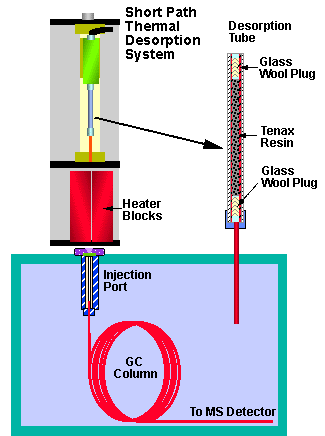
Figure 1 - Short Path Thermal Desorption System
EXPERIMENTAL
The desorption sample tubes consist of 1/4 in. O.D. by 4.0 in. long glass lined stainless steel tubes packed with 200 milligrams of Tenax TA (TM) between two glass wool plugs. Before use, the desorption tubes with adsorbent resins were conditioned in the desorption tube conditioning oven (Scientific Instrument Services, Ringoes, NJ) at a temperature of 300 degrees C for 4 hours with a 10 ml/min flow of high purity nitrogen through the adsorbent resin. This assures that the traps are fully clean and no contamination or cross contamination of samples will occur. After conditioning, the Desorption tubes are capped and sealed with stainless steel caps with PTFE seals until ready for use. Likewise, the desorption tube needles (transfer lines) are also conditioned before use to eliminate any possibility of cross contamination.
Air Sampling: To collect the air samples, a Gilian industrial hygiene air pump was used to pump air samples through the adsorbent traps at a rate of 100 ml/min. The pumping time was varied depending on the volume of air required for analysis. Most air testing only required 1 to 10 liters of air. In the case of the cigarette smoke, only two milliliters were required; therefore, the pumping rate was decreased to 4 ml/min and the cigarette smoke was collected for 30 seconds. The small air pump was used to trap the volatiles from all the air samples studied. It was also used to collect the cigarette smoke and fireplace smoke.
Commercial Products: For the collection of the volatiles from solid finished commercial products (such as the vinyl flooring), the Scientific Instrument Services Solid Sampling Oven was used. The samples to be analyzed were placed inside a 0.5 inch diameter by 14 inch long glass sample tube. This tube was then inserted into the sample oven, heated to 40 degrees C and purged with high purity nitrogen to drive the volatiles off the solid substrate and onto the Tenax Adsorbent traps. Samples were purged for 20 to 30 minutes at a flow rate of 20 ml/min.
Thermal Desorption: The Desorption tube with the trapped volatiles was attached to the Short Path Thermal Desorption System and a preconditioned transfer line needle was attached to the other end of the sample tubes (Figure #1). Helium carrier gas was purged through the desorption tube at room temperature for 1.0 minute to remove any oxygen from the adsorbent resin, after which the sample was injected into the GC injection port. The two heater blocks which were set to 250 degrees C were closed around the desorption tube to ballistically heat the desorption tubes. This combination of ballistic heating and GC carrier gas through the adsorbent resin, sparged any volatiles or semi-volatile resins into the hot GC injection port where they were subsequently cryo-focused at the front of the GC guard column. The desorption process continued for 10 minutes after which the desorption blocks were opened; the sample tube was withdrawn from the GC injection port and the programming of the GC column was commenced to elute the volatiles from the GC capillary column. The total ion chromatogram for each of the samples was plotted and a complete library search of each of the peaks was made using the Wiley NBS library. Blanks were run between samples to assure no cross contamination of samples.
The following series of studies were conducted using the above described technique:
(1) Analysis of Indoor Air Samples From Various Rooms In a Domestic House
(2) Analysis of Indoor Air From Public Buildings
(3) Determination of Volatile Emissions From New Carpeting Installed In a Commercial Office and Study of the Dissipation of the Volatiles With Time
(4) Analysis of Volatiles From Combustion Sources, Including Cigarettes and Fireplaces.
(5) Analysis of Volatile Emissions From Commercial Products Including Cleaning Products, Paper, Perfume, Air Fresheners, Etc.
RESULTS AND DISCUSSION
RESIDENTIAL HOME AIR
The living room air sample (Figure #2) contained a large number of compounds including: benzene, toluene and the xylenes. In addition, several terpenes including the largest peak limonene were detected. Limonene was detected in most of the air samples analyzed. In addition to occurring naturally in citrus fruits, limonene is widely used in many commercial products including laundry soaps, cleaning products, furniture polishes, and other domestic products, as will be demonstrated later. In addition, a number of straight chain hydrocarbons from Hexane through Heptadecane were also detected, as well as several of their corresponding aldehydes. Ten liters of the living room air produced peaks corresponding to levels of detection in the parts per billion (ppb) level for most of the compounds detected in this chromatogram.
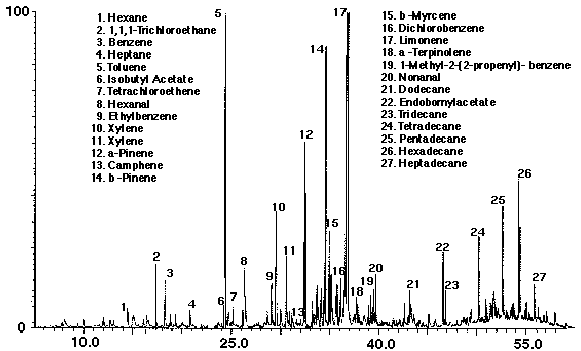
Figure 2 - Living Room Air
Six liters of air were analyzed for the kitchen air sample in Figure # 3. This sample was taken in the kitchen during the cooking of tomato sauce. In addition to the same compounds detected in the living room air sample, a large number of terpenes and sesquiterpenes were detected and identified, originating from the many spices being used in the kitchen. The largest peak in the chromatogram is still limonene which probably originates from the cleaning products used in the kitchen.
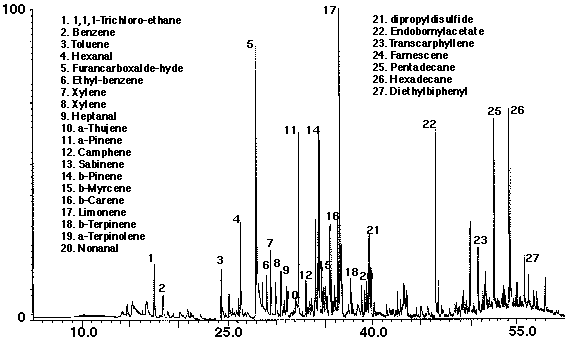
Figure 3 - Kitchen Air
Ten liter samples of air from a basement game room (Figure #4) and a finished Breezeway (Figure #5) exhibit a wide range of substituted benzene type compounds, several chlorinated hydrocarbons, several hydrocarbons, and terpenes including limonene. Many of the compounds identified originated from the vinyl flooring installed in both of these rooms. In particular, the levels of benzene and toluene were quite high in both of these samples.
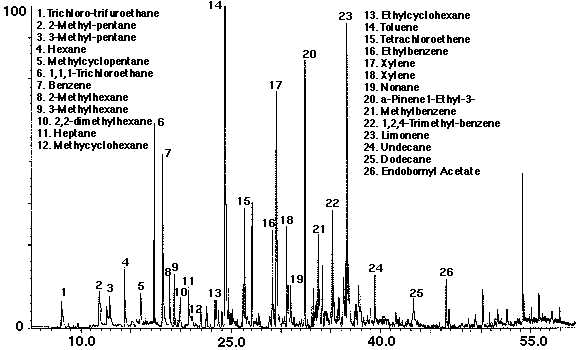
Figure 4 - Basement Game Room Air
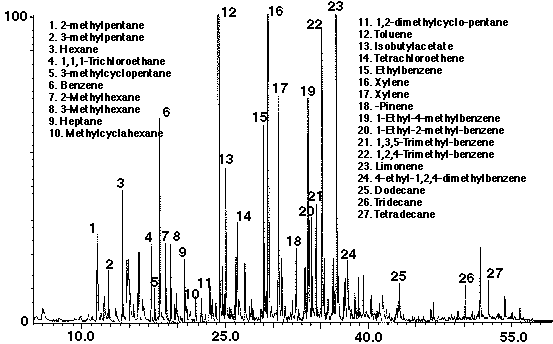
Figure 5 - Finished Breezeway Air
Fifteen liters of air from a residential garage are shown in Figure #6. A large number of substituted benzenes and hydrocarbons indicative of gasoline were identified in this sample. They originated from the automobiles and lawn equipment stored in this facility. Toluene and the Xylenes were the major compounds present in this sample.
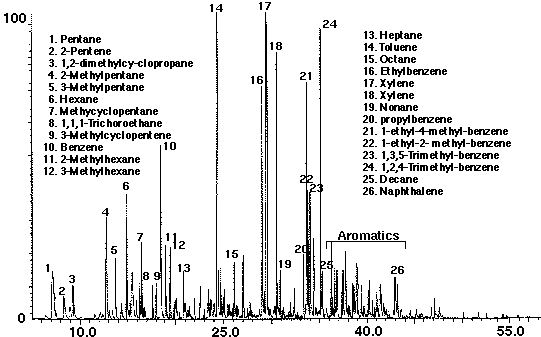
Figure 6 - Residential Garage Air
PUBLIC BUILDINGS
A 3.0 liter sample of air from a recent scientific instrument trade show is illustrated in Figure # 7. Many of the same aromatics and hydrocarbons that were present in the domestic house samples were detected in this sample, but at about 4 times the concentration. The major compounds present were benzene and tetrachloroethene. In addition, benzaldehyde and naphthalene were also present in relatively high concentrations.
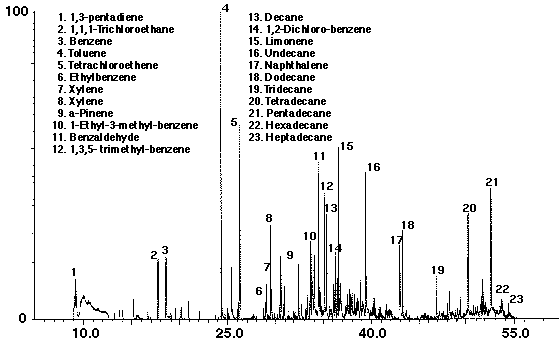
Figure 7 - Trade Show Air
Commercial buildings exhibited many of the same compounds present in the previous samples analyzed. Twelve liters of air from an industrial warehouse are shown in Figure # 8. Many of the same compounds routinely seen in the previous air samples were once again evident in this sample. The major peaks present were Trichloroethane and toluene. Eighteen liters of air from the kitchen area of a commercial building are shown in Figure # 9. A few furan base compounds which probably originated from coffee brewing in this area were detected in this sample.
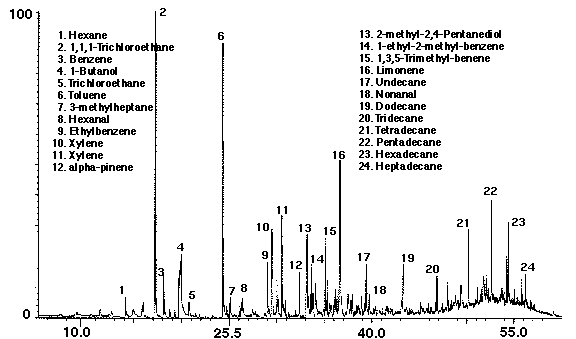
Figure 8 - Industrial Warehouse Air
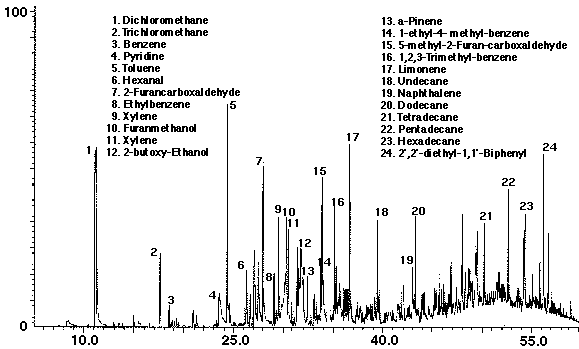
Figure 9 - Lunch Area of Commercial Building Air
Figure #10 is the air sample from a restaurant. Many of the same volatile organics present in domestic kitchen air are present in this sample-with the exception of the naphthalene. The major components were limonene and toluene.
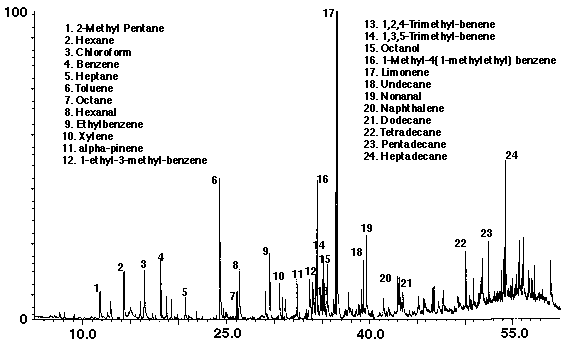
Figure 10 - Restaurant Air
Figure #11 is the result of sampling 300 ml of air at the window on the drivers side of the car while it was being serviced at a gas station. This sample was taken during the winter, when the outside air temperature was less than 30 degrees F. The lack of higher boiling compounds is evident due to this low temperature. The compounds identified include a large number of substituted benzenes and hydrocarbons indicative of gasoline.
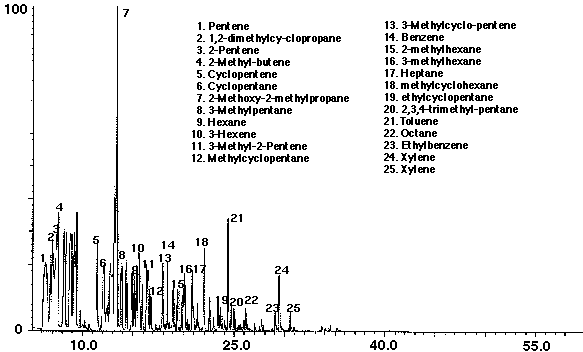
Figure 11 - Drivers Side of Car - Air From Window While Being Serviced At a Gas Station
VOLATILES FROM NEWLY INSTALLED INDOOR CARPETING
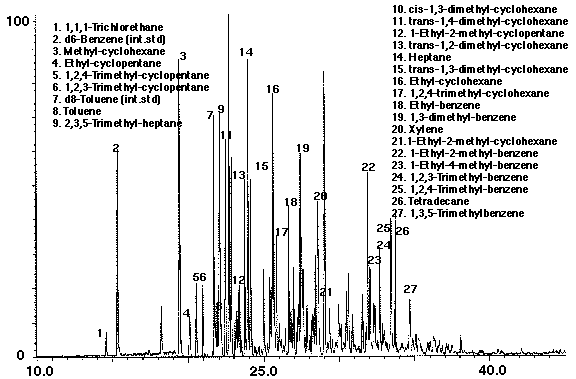
Figure 12 - Commercial Office Air After New Carpet Installation
Figure #12 is the total ion chromatogram of 500 ml of air from a commercial office after the installation of new indoor carpeting. The carpet was installed using glue to hold it in place. Before this sample was analyzed, 100 nanogram of deuterated benzene and toluene were added to the Tenax TA (TM) trap as internal standards for the quantification of the volatiles present. This air sample contains a large number of substituted cyclohexanes and benzenes which originated from the glue which was used to install the carpeting. Additional air samples were taken before the new carpet installation and subsequently every day for 60 days after the carpet was installed. The carpet was installed in the summer and the room was aired out every day to help dissipate the volatiles. The total concentration of all the volatiles present was calculated using the deuterated internal standards as a concentration reference. The results of the total volatiles present in the office air were then plotted for each day (Figure 13). It took more than 20 days for the total volatiles to return to the pre-carpet installation levels. Had this new carpet installation occurred in the winter, when the building would be more tightly closed, this process would have taken much longer.
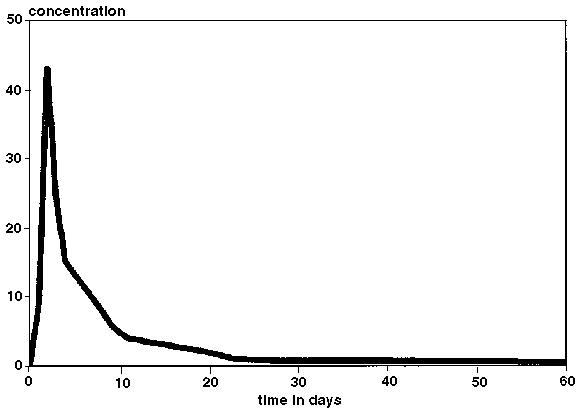
Figure 13 - Volatiles In Air After Carpet Installation
CIGARETTES AND COMBUSTION PRODUCTS
The smoke from a cigarette was analyzed (Figure 14). Only 2.0 ml of air were required for this sample. This was an unfiltered cigarette. The nicotine peak is the major peak and was present in the parts per hundred level (pph). The second hand smoke from cigarettes has recently come under renewed attack . This technique will accurately detect and identify the emissions from cigarettes and will prove to be a useful technique.
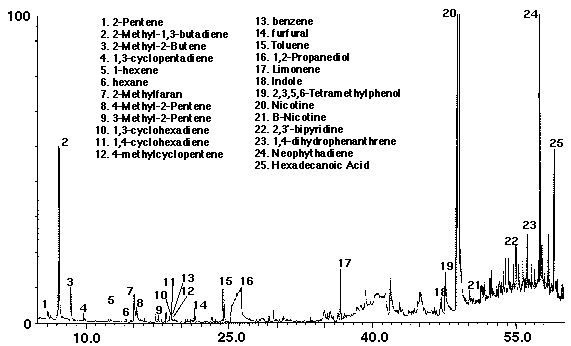
Figure 14 - Air From Cigarette Smoke
Smoke from a fireplace was analyzed (Figure 15). Forty milliliters of air were collected from above the fire in a residential fireplace. The fire was burning for about 1 hour and was hot when this sample was taken. As expected, a large number of substituted phenols from the combustion of the fire wood were identified. In addition high levels of Benzene, Toluene and xylenes were also detected.
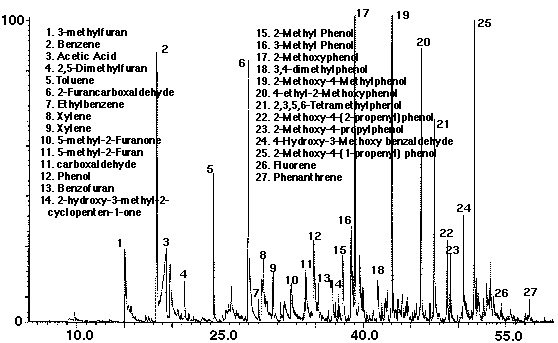
Figure 15 - Smoke From a Fireplace
COMMERCIAL PRODUCTS
Volatiles and semi-volatiles from the solid commercial products were analyzed by first placing the solid sample into the S.I.S. Solid Sampling Oven, purging the sample with high purity nitrogen and trapping the volatiles on Tenax adsorbent traps. A purge and trap apparatus could also have been used to purge and trap these volatiles; however, the Solid Sampling Oven is much more efficient at purging the semi-volatiles from solid matrix samples.
The volatiles emitted from fourteen grams of vinyl flooring are shown in Figure # 16. This was plain vinyl flooring without any glue. The major peaks identified include 2,3-Butanedione, benzaldehyde, and naphthalene. Additionally, a large number of substituted benzenes and hydrocarbons were also identified in this sample.
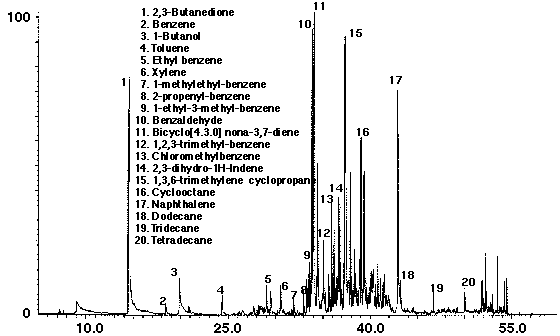
Figure 16 - Volatiles Emitted from Vinyl Flooring
Another common source of indoor air contamination are paints. Most paints used today are latex paints. As shown in Figure # 17, these products produce significant levels of volatiles, including hydrocarbons and aromatics. The sample analyzed was only the volatiles emitted from 7 nanograms of the liquid latex paint.
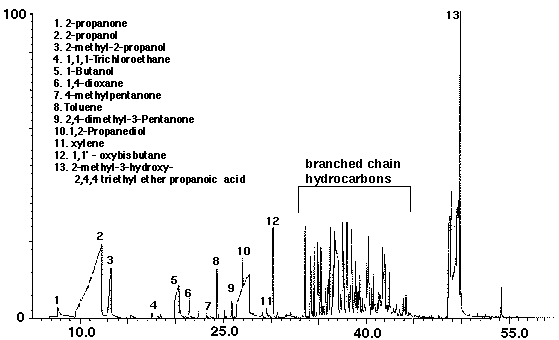
Figure 17 - Air from Liquid Latex Paint
Residential Air Fresheners (Figure 18) and Perfumes (Figure 19) are also sources of indoor air contamination. Both of these products contain a diverse variety of terpenes and sesquiterpenes originating from natural sources such as flower extracts. Limonene is a major component in both of these products.
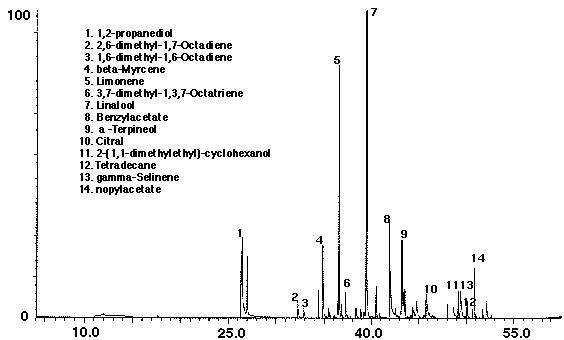
Figure 18 - Residential Air Fresheners
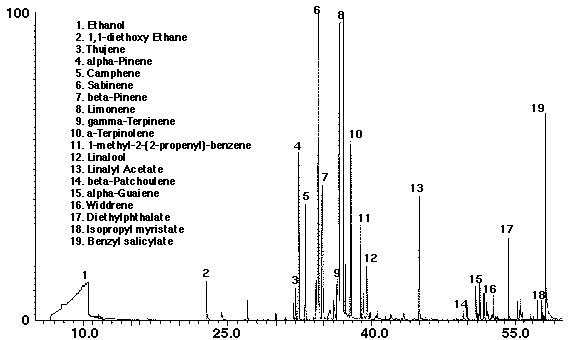
Figure 19 - Volatiles Emitted From Perfume
Many other household products including Furniture Polish (Figure 20) and Household laundry soap (Figure 21) also exhibit a large number of volatile emissions. The furniture polish contained large quantities of branched chain hydrocarbons and terpenes of which limonene was the major component. The laundry soap sample also exhibited a large number of terpene type compounds including limonene and camphor.
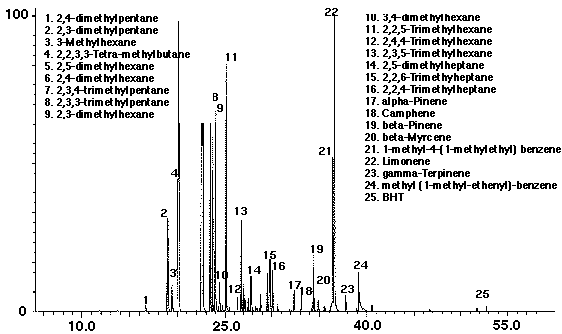
Figure 20 - Emissions From Furniture Polish
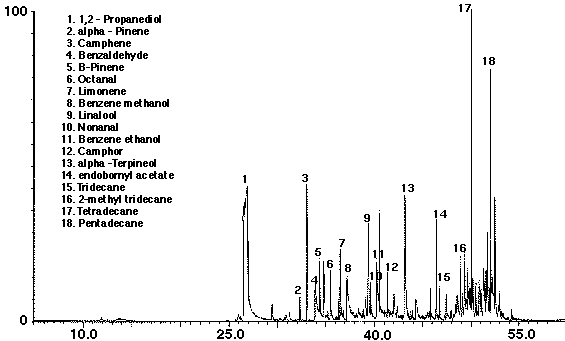
Figure 21 - Volatile Emissions From Household Laundry Soap
Paper products also are a major source of volatile emissions in the indoor air environment. Figure # 22 shows the volatile emissions from a paper table cloth. The table cloth was sealed in a plastic bag. When opened, a strong, rancid odor was evident. Subsequent analysis of the 300 ml of air from inside the package indicated high levels of aldehydes and their corresponding acids which undoubtedly were the source of the rancid odor. There appears to be a paper rancidity problem with this product. A sample of the volatile emissions from a magazine paper is shown in Figure # 23. The major peak in this sample was toluene and several substituted benzenes, probably originating from the inks or paper finishing products.
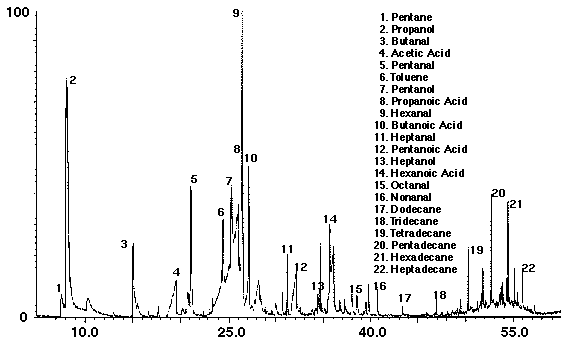
Figure 22 - Volatiles Emitted From a Paper Table Cloth
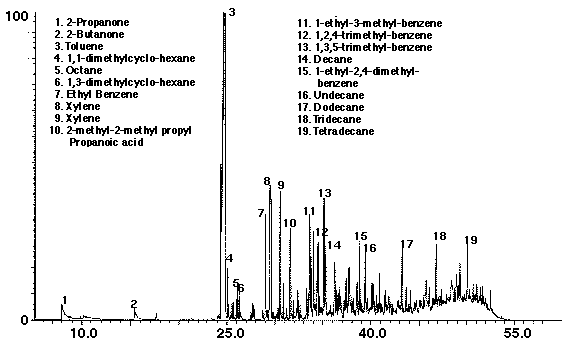
Figure 23 - Volatile Emissions From a Magazine Paper
CONCLUSION
Many products which are used in the home and workplace are responsible for contributing to the levels of volatiles in the indoor air environment. A large number of aromatics, hydrocarbons, halogenated hydrocarbons, phenols, furans, terpenes and sesquiterpenes are emitted from these products. Individually, the contribution from any one product may not be significant. However, the cumulative levels of emissions from these products are increasingly becoming a major concern. This is particularly noteworthy in the new energy efficient construction which minimizes air exchange due to the tight construction of these buildings. In the future, the levels and extent of the volatile organics in indoor air will come under closer scrutiny by both the public and scientific communities. The technique of trapping the volatiles as well as the semi-volatiles on Tenax TA (TM) adsorbent traps and the subsequent analysis using the Short Path Thermal Desorption System has proven to be a useful technique for the analysis of indoor air samples as well as the products which are the sources of indoor air contamination.

